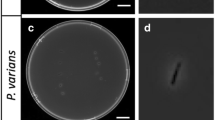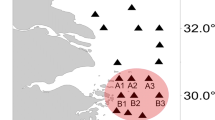Abstract
From the observed pattern of aminopeptidase and alkaline phosphatase activities in the Baltic Sea, the question arose whether there is an interaction between the activities of both enzymes. In experiments with 0.8 μm filtered seawater, the effects of commercial alkaline phosphatase on bacterial aminopeptidase, the effects of commercial peptidase on bacterial alkaline phosphatase activity (APA), and the effects of proteins, carbohydrates and inorganic nutrients on the activities of both enzymes were investigated.
Addition of commercial alkaline phosphatase stimulated bacterial aminopeptidase activity and, similarly, the addition of commercial peptidase increased the APA in bacteria. The proteins, albumin and casein, stimulated aminopeptidase activity and APA simultaneously. Experiments using ammonium and glucose suggested that stimulation of APA by peptidase could be mediated by nitrogen and carbon availability. There were also some indications that stimulation of aminopeptidase activity by alkaline phosphatase functioned by catalysing phosphate release from organic phosphorus compounds.
Similar content being viewed by others
References
Ammerman JW (1991) Role of ecto-phosphorylases in phosphorus regeneration in estuarine and coastal ecosystems. In Chróst RJ (ed.), Microbial Emzymes in Aquatic Environments, Springer-Verlag, New York, pp. 165–186.
Billen G (1991) Protein degradation in aquatic environments. In: Chróst RJ (ed.), Microbial Enzymes in Aquatic Environments, Springer-Verlag, New York, pp. 123–143.
Boetius A and Lochte K (1994) Regulation of microbial enzyme degradation of organic matter in deep-sea sediments. Mar Ecol Prog Ser 104: 299–307
Boetius A and Lochte K (1996) Effect of organic enrichments on hydrolytic potentials and growth of bacteria in deep-sea sediments. Mar Ecol Prog Ser 140: 239–250
Carlsson P and Graneli E (1993) Availability of humic bound nitrogen for coastal phytoplankton. Estuar Coast Shelf Sci 36: 433–447
Chappel RK and Goulder R (1995) A between-river comparison of extracellular-enzyme activity. Microbiol Ecol 29: 1–17
Chróst RJ and Overbeck J (1989) Substrate-ectoenzyme interaction: significance of _-glucosidase activity for glucose metabolism by aquatic bacteria. Arch Hydrobiol Ergebn Limnol 34: 93–98
Chróst RJ (1990) Microbial enzymes in aquatic environments. In: Overbeck J, Chróst RJ (eds.), Aquatic Microbial Ecology, Biochemical and Molecular Approaches. Springer Verlag, New York, pp. 47–79.
Chróst RJ (ed.) (1991) Environmental control of the synthesis and activity of aquatic microbial enzymes. Microbial Enzymes in Aquatic Environments, Springer-Verlag, New York, pp. 29–84.
Franko DA (1984) Relationship between phosphorus functional classes and alkaline phosphatase activity in reservoir lakes. J Freshwat Ecol 2: 541–547
Fontigny A, Billen G and Vives-Rego J (1987) Some kinetic characteristics of exoproteolytic activity in coastal seawater. Estuar Coast Shelf Sci 25: 127–133
Gage MA and Gorham E (1985) Alkaline phosphatase activity and cellular phosphorus as an index of the phosphorus status of phytoplankton in Minnesota lakes. Freshwat Biol 15: 227–233
González-Gil S, Kaefer BA, Jovine RVM, Aguilera A, Lu S and Anderson DM (1998) Detection and quantification of alkaline phosphatase in single cells of phosphorus-starved marine phytoplankton. Mar Ecol Prog Ser 164: 21–35
Grasshoff K, Ehrhardt M and Kremling K (eds) (1983) Methods of seawater analysis, 2nd edition, Verlag Chemie, Weinheim, pp. 1–419.
Hino S (1989) Fluctuation of algal alkaline phosphatase activity and the possible mechanisms of hydrolysis of dissolved organic phosphorus in Lake Barato. Hydrobiol 157: 77–84
Hollibaugh JT and Azam F (1983) Microbial degradation of dissolved proteins in seawater. Limnol Oceanogr 28: 1104–1116
Hernsdorf CL and Simmonds S (1980) Role of peptidases in utilization and transport of peptides by bacteria. In: Payne JW (ed.) Microorganisms and Nitrogen Sources, JohnWiley & Sons, New York, pp. 301–334.
Hoppe HG (1993) Use of fluorogenic model substrates for extracellular enzyme activity (EEA) measurement of bacteria. In: Kemp PF, Sherr BF, Sherr EB, Cole JJ (eds) Handbook of Methods in Aquatic Microbial Ecology. Lewis Publishers, Boca Raton, pp. 423–431
Hoppe HG and Ullrich S (1999) Profiles of ectoenzymes in the Indian Ocean: Phenomena of phosphatase activity in the mesopelagic zone. Aquat Microbiol Ecol 19: 139–148
Kaiser W, Nehring D, Breuel G, Wasmund N, Siegel H, Witt G, Kerstan E. and Sadkowiak B (1995) Zeitreihen hydrographischer, chemischer und biologischer Variablen an der Küstenstation Warnemünde (westliche Ostsee). Meereswiss Ber 11: 2–65
Karner, M, Rassoulzadegan, C and Rassoulzadegan, F (1995) Extracellular enzyme activity: indications for short-term variability in a coastal marine ecosystem. Microbiol Ecol 30: 143–156
Martinez J and Azam F (1993) Periplasmatic aminopeptidase and alkaline phosphatase activities in a marine bacterium in the sea. Mar Ecol Prog Ser 92: 89–97
Martinez J, Smith DC, Steward GF and Azam F (1996) Variability in ectohydrolytic enzyme activities of pelagic marine bacteria and its significance for substrate processing in the sea. Aquat Microbiol Ecol 10: 223–230
Matthäus W, Nausch G, Lass HU, Nagel K and Siegel H (1999) Hydrographisch-chemische Zustandseinschätzung der Ostsee 1998. Meereswiss Ber 35: 1–69
Münster U (1991) Extracellular enzyme activity in eutrophic and polyhumic lakes. In Chróst RJ (ed.) Microbial Enzymes in Aquatic Environments, Springer-Verlag, New York, pp. 96–123
Myklestad S and Sakshaug E (1983) Alkaline phosphatase activity of Skeletonema costatum populations in the Trondheimfjord. J Plankton Res 5: 557–564
Nausch M (1998) Alkaline phosphatase activities and the relationship to inorganic phosphate in the Pomeranian Bight (southern Baltic Sea). Aquat Microbiol Ecol 16: 87–94
Nausch M, Pollehne F and Kerstan E (1998) Extracellular enzyme activities in relation to hydrodynamics in the Pomeranian Bight (southern Baltic Sea). Microbiol Ecol 36: 251–258
Nausch M and Nausch G (2000) Stimulation of peptidase activity in nutrient gradients. Soil Biol Biochem 32: 1973–1989
Rath J, Schiller C and Herndl GJ (1993) Ectoenzymatic activity and bacterial dynamics along a trophic gradient in the Caribbean Sea. Mar Ecol Prog Ser 102: 89–96
Rodriguez R, Garcia-Gonzalez M, Guerrero G and Lara C (1994) Ammonium-sensitive protein kinase activity in plasma membranes of the cyanobacterium Anacystic nidulans. FEBS Lett 350: 19–23
Rohde KH and Nehring D (1979) Ausgewählte Methoden zur Bestimmung von Inhaltsstoffen im Meer-und Brackwasser. Geod Geoph Veröff R.IV 27: 1–68
Rose C and Axler RP (1998) Uses of alkaline phosphatase activity in evaluating phytoplankton community phosphorus deficiency. Hydrobiologia 361: 145–156
Sakshaug E, Graneli E, Elbrächter M and Kayser H (1984) Chemical composition and alkaline phosphatase activity of nutrientsaturated and P-deficient cells of four marine dinoflagellates. J Exp Mar Biol Ecol 77: 241–254
Sieracki ME, Charles LV and Webb KL (1989) Algorithm to estimate cell biovolume using image analysed microscopy. Cytometry 10: 551–557
Stewart AJ and Wetzel RG (1982) Influence of dissolved humic materials on carbon assimilation and alkaline phosphatase activity in natural algal-bacterial assemblage. Freshwat Biol 12: 369–380
Stinson R and Chan JRA (1987) Alkaline phosphatase and its function as protein phosphatase. Adv Prot Phosphatases 4: 127–151
ESCO (1994) Protocols for the Joint Global Ocean Flux Study (JGOFS) core measurements. IOC/SCOR Manual and Guides 29: 128–134
Vetter YA and Deming JW (1994) Extracellular enzyme activity in the Arctic Northeast Water polynya. Mar Ecol Prog Ser 114: 23–34
Vincent JB and Crowder MW (eds) (1995) Phosphatases in Cell Metabolism and Signal Transduction: Structure, Function and Mechanism of Action. Springer-Verlag, New York
Author information
Authors and Affiliations
Rights and permissions
About this article
Cite this article
Nausch, M. Experimental evidence for interactions between bacterial peptidase and alkaline phosphatase activity in the Baltic Sea. Aquatic Ecology 34, 331–343 (2000). https://doi.org/10.1023/A:1011482815250
Issue Date:
DOI: https://doi.org/10.1023/A:1011482815250




